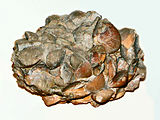Terebratula
| Terebratula Temporal range:
| |
|---|---|

| |
| Terebratula maugerii from the Upper Miocene of Cordoba, Spain. | |
| Scientific classification | |
| Kingdom: | |
| Phylum: | |
| Class: | |
| Order: | |
| Family: | |
| Genus: | Terebratula Müller, 1776
|
| Species | |
Terebratula is a modern genus of brachiopods with a fossil record dating back to the Late Devonian. These brachiopods are stationary epifaunal suspension feeders and have a worldwide distribution.
Description[]
Terebratula species have biconvex egg-shaped shells, anterior margins of the valves have two small folds, concentric growth lines are quite thin or nearly absent. The larger valve has a ventral umbo with the opening through which they extend a short peduncle.[1]
Selected species[]
|
|
|
Reassigned species[]
As Terebratula has been erected early on in paleontology, many species have since been reassigned to other genera.[2]
|
|
Gallery[]

Terebratula longirostris fossil at the Geological Museum, Copenhagen
Terebratula sp. from the Triassic of Bolzano, Italy
References[]
- ^ Taylor, Paul D.; Lewis, David N. (2007). Fossil Invertebrates. Harvard University Press. p. 208. ISBN 978-0674025745.
- ^ Moore, R.C. (1965). Brachiopoda. Treatise on Invertebrate Paleontology. Vol. Part H., Volume 1 and 2. Boulder, Colorado/Lawrence, Kansas: Geological Society of America/University of Kansas Press. pp. H21, H32, H43-46, H100, H206, H208, H210, H820, H831. ISBN 0-8137-3015-5.
- ^ a b c d e f g h i j Emig, Christian C. (2012). "Révision des espèces de brachiopodes décrites par A. Risso [Revision of the brachiopod species described by A. Risso]" (PDF). Carnets de Géologie (Article 2012/02 (CG2012_A02) 15). doi:10.4267/2042/45933.
- ^ Sartenaer, P. (2010). "Re-examination of the Late Emsian rhynchonellid (brachiopod) Terebratula Daleidensis Roemer, 1844 from the Eifel area, and some related species" (PDF). Bulletin de l'Institut Royal des Sciences Naturelles de Belgique, Sciences de la Terre. 80: 47–84. ISSN 0374-6291.
- ^ Asgaard, Ulla (1972). "Observations on Neoliothyrina fittoni - a rare Maastrichtian terebratulid from NW Europe" (PDF). Bulletin of the Geological Society of Denmark. 21: 337–345.
- ^ Sartenaer, Paul (2005). "Restatement of Terebratula orbignyana De Vernieuil, 1850, on the basis of the original collection" (PDF). Bulletin de l'Institute royal des Sciences naturelles de Belgique, Sciences de la Terre. 74-supplement: 81–88.
External links[]
Categories:
- Terebratulida
- Prehistoric brachiopod genera
- Devonian brachiopods
- Carboniferous brachiopods
- Permian brachiopods
- Mesozoic brachiopods
- Cenozoic brachiopods
- Prehistoric animals of Africa
- Extinct animals of Antarctica
- Prehistoric animals of Asia
- Prehistoric invertebrates of Oceania
- Prehistoric animals of Europe
- Prehistoric brachiopods of North America
- Mesozoic animals of South America
- Cretaceous Colombia
- Fossils of Colombia
- Extant Late Devonian first appearances


